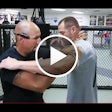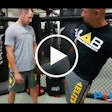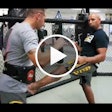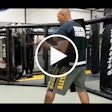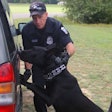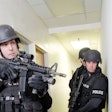Law enforcement trainers are constantly striving for more realistic training, because they know that the more real it is, the more officers will learn and retain. In the use of force arena, most training can be placed along a continuum, ranging from absolute safety on one end to absolute reality on the other.
"Absolute safety" in the context of TASER training would mean looking at pictures of TASERs and talking about how to use them, without any actual handling of the units. "Absolute reality," on the other hand, would mean live hits with fully functional cartridges, in the front of the body, during aggressive, confrontational scenarios, with no protective gear, anD no "spotters" to catch the subject after they are "tased."
Obviously, neither approach to TASER training is desirable from a professional trainer's standpoint. Just talking about it is largely meaningless without the actual tactile experience of manipulating the weapon, and shooting a "suspect" with a live cartridge and no safety protocols in place is not justified by the imprimatur of training safely and effectiveness.
A compromise must be realized between the two extremes. Trainers need to deliver the most meaningful and effective training possible, while keeping their trainees as safe as practical.
A reasonable solution to this question is to conduct live training with TASERs, but to do so utilizing safety protocols geared to reduce the potential for unnecessary harm to the trainee. TASER International has included guidelines in every TASER Instructor Manual on how to conduct such training.
First, a suitable location must be found. Ideally, the training site would be enclosed so that passers-by will not be able to observe the training. This is especially true if the training is to be done out-of-doors. There should be no view of the training area from a roadway, where motorists may be distracted by seeing the training. Keep in mind that there is nothing "secret" or classified about the training – this precaution is only taken to reduce the possibility that a pedestrian or motorist will be injured or distracted.
The training site, or room, should be capable of being secured, so that uninvolved individuals cannot enter. If observers are to be allowed, they should be restricted to a controlled area, and should be required to wear protective eyewear, as should everyone in the training venue when cartridges are being fired.
Anyone participating in live TASER exposure training should be provided with a printed "advice of risk" form, which clearly outlines the possible effects of a TASER "hit." The form should clearly state that, while the risk of injury is low, it is not non-existent. Additionally, the form should provide a place for the traineeS to indicate if they have any injury, recent surgery, or other condition that would preclude them from participating in the training. The forms should be signed by the trainees, and collected for the department's training file. A sample form is included in every TASER International Instructor Manual.
The TASER Instructor should do the actual firing of cartridges during live TASER exposure training. This will ensure that the Instructor has the necessary control of the training environment. Trainees can gain experience in manipulating TASER weapons through dry-fire drills, and use of live cartridges on stationary, inanimate targets.
The training should be conducted on training mats, so as to reduce the possibility of fall injuries or rug burns. Care should be taken to make sure that the training area is clear of tables, chairs, and other objects that could injure a trainee in a fall.
The trainee to be "tased" should face away from the Instructor, in order to reduce the possibility of a facial or throat hit. Two class members should be enlisted as spotters. Each spotter should hold the trainee by an arm, with one hand on the trainee's wrist, and the other under the trainee's armpit. Spotters should stand slightly apart from the trainee, but not with the trainee's arms extended to the side.
After the TASER cartridge is fired, the spotters should lower the trainee to the floor, and then step forward and away. Two other trainees should then move in while the TASER is still activated, and take control of the "suspect" by handcuffing him or her.
This scenario will facilitate the training of the other members of the class in several ways: They will see the effects of a TASER hit, and they will see that officers can take hold of an individual that is being "tased" without being shocked themselves. This "cuffing under power" is an important aspect of a TASER deployment, in that it reduces the likelihood of injury to officers and suspects, and reduces the possible need for additional TASER activations.
During this "cuffing under power," the "arresting officers" should use proper verbal commands, and actual handcuffing techniques. Following the "arrest," trainees should practice proper probe removal protocols, followed by proper securing of probes and other "evidence," such as TASER wire and AFIDs, if the department requires that.
TASER training exposures should be for the full five-second "ride," as that is the most realistic scenario. Additionally, TASER International no longer recommends the use of group exposures, as the practice of interlinking arms or fingers may cause an injury.
Probe removal should be carried out by trainees using proper safety protocols, including universal precautions, such as protective gloves and "sharps" containers. Alcohol wipes and band-aids should be used on the probe penetration sites. Before probes are disposed of, they should be inspected to ensure that the probe is still intact after removal.
Officers need the safest, most realistic training possible. If a department follows proper safety protocols, and incorporates realistic arrest simulations into their TASER training, it will pay dividends when officers use TASERs on the street.
Stay Safe, and wear your vest (and Buckle Up)!






